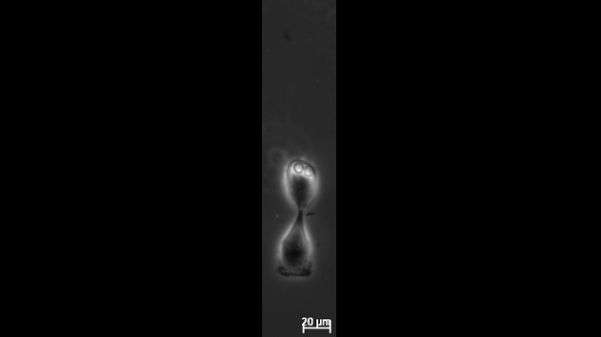How breast cancer cells slide to metastasis

The spreading of cancer cells from one part of the body to another, a process known as metastasis, is the leading cause of death among cancer patients. A study published April 26 in Biophysical Journal now reveals why some cancer cells may be more metastatic than others. The findings show that breast cancer cells spread to other parts of the body by sliding around other cells blocking their escape route out of the original tumor.
"We demonstrate a quantitative ruler for measuring how well a cell is able to slide," says senior study author Anand Asthagiri of Northeastern University. "By putting numbers to this cellular behavior, we can not only discern which pathways regulate sliding, but also how much. This opens the door to finding the most powerful drivers of sliding behavior and strategies to curb this invasive behavior."
To invade other tissues in the body, cancer cells migrate along collagen protein fibers that serve as a path out of the original tumor. But these fibers are very narrow and the microenvironment is crowded with other cells, so it has not been clear how metastatic cancer cells get past obstacles and successfully navigate this spatially constrained environment.
"Keep in mind that each cell is 10-15 micron wide and is finding a way to slide past a neighbor, also 10-15 micron wide. And they do all this on a track that is only 5 μm wide," Asthagiri says. "How they physically squeeze, extend and wrap around is really remarkable and a fascinating biophysical problem. We were very interested in sorting out the mechanics and regulation of how cells accomplish this, and why cancer cells are particularly adept at it."
To answer this question, Asthagiri and his team stamped a glass surface with micropatterned lines of fibronectin protein, and then used time-lapse microscopy to study collisions between pairs of cells deposited on the adhesive fibers. On micropatterns that were only 6 μm or 9 μm wide, mimicking conditions in the tumor environment, 99% of normal breast cells stopped and reversed direction upon physical contact with another cell. By contrast, about half of metastatic breast cancer cells responded to collisions by sliding past the other cell, maintaining their migratory path along the protein track.
However, the normal breast cells were much more likely to slide past other cells when the researchers either increased the micropattern width to 33 μm, or reduced levels of E-cadherin—a sticky membrane protein that binds cells together. Meanwhile, increased levels of E-cadherin diminished the sliding behavior of metastatic breast cancer cells.
Additional experiments revealed that PARD3, ErbB2, and TGFβ—proteins implicated in metastasis—cooperate to regulate cell-sliding behavior. Taken together, the findings demonstrate the key role of cell sliding in supporting metastasis, and the molecular pathways that allow this to happen.
In future studies, it will be important to test whether the findings extend to more complex, realistic conditions mimicking the tumor environment, in which different cell types often collide with each other. For their own part, the researchers plan to further explore the underlying molecular mechanisms and test whether the system they developed can be used as a screening platform to find molecular targets that inhibit cell sliding.
"Because our results provide a ruler to measure the extent to which genetic perturbations enable sliding, it offers a way to rank order molecular pathways and to identify combinations of genes that have synergistic effect on sliding potential," Asthagiri says. "Sliding, and we believe invasiveness more broadly, is a property that's progressively accrued, with each cancer-promoting event measurably shifting the degree of invasiveness. Having a ruler allows us to quantify how far cells have transformed and how effective one therapy is versus another."
More information: Biophysical Journal, Milano et al.: "Regulators of Metastasis Modulate the Migratory Response to Cell Contact under Spatial Confinement" www.cell.com/biophysj/fulltext … 0006-3495(16)30113-8. DOI: 10.1016/j.bpj.2016.02.040
















